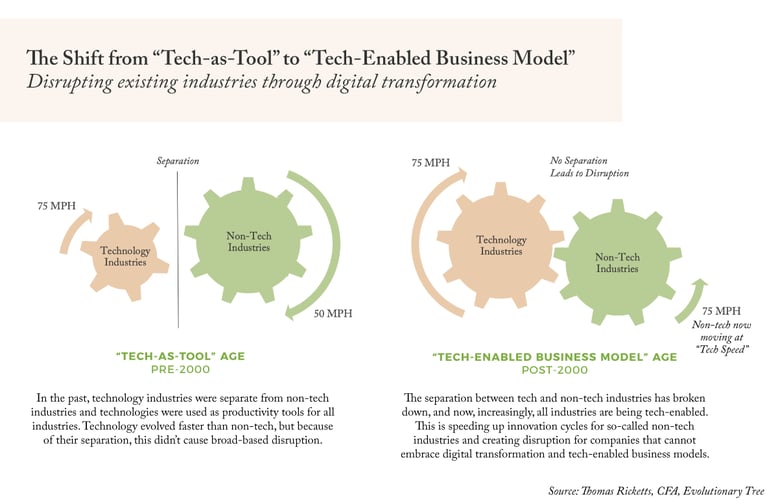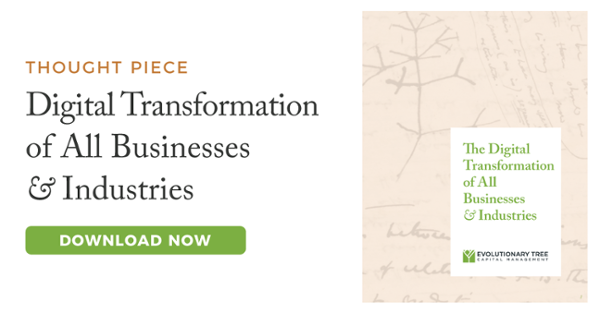There are certain types of technologies that have the power to transform companies and even entire industries. Academics call these technologies “general-purpose technologies.” Their development and evolution have often been the underlying engine of economic development and productivity jumps. They also can spawn a number of value-adding investments for investors. This blog post focuses on the current general-purpose technologies transforming all industries today, collectively described as “Digital Transformation.” As we lay out below, Digital Transformation is far from complete.
Academics define general-purpose technologies (GPTs) as foundational technologies that enable many applications with broad, significant cumulative impact on society. GPTs go all the way back to the stone age. Examples of GPTs include stone tools to aqueducts, the water mill to steam engines, and on to electricity and the computer.
We are now living through one of the most important GPT waves in history: the Digital Transformation of all businesses and industries. Called different things over the years—the Digital Age, the Digital Revolution, the Fourth Industrial Revolution (Industry 4.0), or just Digitization—its impact is accelerating and broadening. Entire industries are now feeling the heat of Digital Transformation. This heat comes from all directions, with consumers expecting an Amazon-like user experience, younger digital native workers pushing for more end-to-end digital processes, or, competitively, to the emergence of digital startups and non-traditional players disrupting an industry using innovative new digital business models.
Shifting from Tech-as-Tool to Tech-Enabled Business Models
Digital technology is shifting from merely a discrete tool to enhance productivity to now becoming weaved throughout the foundation of every business and across every value chain, sometimes creating entirely new business models that threaten old ones. Digitization, defined as the use of information technology—from computers and communication networks to software and cloud-based technologies—to improve productivity and value creation, has been felt on the margins for years. Recently, however, its power has grown to new heights. Think of this change as moving from the “tech-as-tool” stage to a “tech-enabled business model” stage.
In the 80s and 90s, computers were largely supplementary to business processes. The advent of the web and e-commerce in the late-90s began to show the contours of how digitization could more substantially threaten or reshape industries, in this case mostly retail and distribution. Now, with Web 2.0 technologies, mobile computing, cloud computing, and “software eating the world” driving greater end-to-end automation, all industries are now seeing varying degrees of transformation. It is not just retail being upended; we now see it in media (shift to digital streaming), banking (newer forms of electronic payments), transportation (on-demand taxi services), and many other industries.
The bottom-line is that we now live in an age where the underlying technologies of digitization can be combined to transform entire industries and create a new species of tech-enabled companies. Leading companies are doing more than re-tooling, they are fundamentally re-architecting their businesses using these new digital tools. This is forcing so-called non-tech companies and industries to embrace digitization and now move at “tech speed” (see diagram below).
 For example, digital video streaming is upending the traditional TV and movie production and distribution industries. Media, while an obvious example of Digital Transformation, is not the only one. Industries that are not known for being technologically advanced, from insurance and financial institutions to auto manufacturers and healthcare companies, are feeling the heat to embrace digitization and experiment with new digital business models.
For example, digital video streaming is upending the traditional TV and movie production and distribution industries. Media, while an obvious example of Digital Transformation, is not the only one. Industries that are not known for being technologically advanced, from insurance and financial institutions to auto manufacturers and healthcare companies, are feeling the heat to embrace digitization and experiment with new digital business models.
The reasons for embracing digitization are both defensive (as described above) and offensive. Recent studies have shown that companies that invest in and develop digital business models deliver better financial performance. The MIT Center for Information Systems Research (CISR) conducted a study of 130 businesses and found that regardless of industry, those companies that scored in the top third of financial performance (growth and profitability metrics) had 20-40% higher measures on adoption and deployment of various digital processes and models.
Digital Transformation and Cloud Computing Still have Many Years of Growth Left in the Tank
What gives us confidence there is still room for growth in this trend? Various studies that we have reviewed show that cloud computing and software-as-a-service (SaaS)—the core GPTs for digital transformation—have been adopted by only 15-20% of the users or use cases, leaving plenty of room for above-average growth to the future. And, this data tends to be US-focused, with ex-US enterprises even less penetrated. One illustrative data point is the 2019 JP Morgan CIO Survey, which showed that cloud computing is only about 17.6% of IT spending. CIOs in the survey indicated that they project an increase in cloud computing to 41.1% of their IT spending over the next five years. We believe cloud computing could ultimately comprise over 80% of IT spending in the very long term.
Implications for Investors of Digital Transformation
The rise of Digital Transformation has multiple implications for today’s investors. For example, the traditional sector and industry classifications are becoming increasingly less valuable. With the boundaries between industries blurring, especially as technology companies invade more non-tech industries, it is important to re-evaluate what constitutes an industry and who the relevant competitors are to monitor. Equally important, there are significant investment opportunities in companies that enable these digital transformations, from horizontal cloud providers to industry-specific software, data, and service providers.
The big picture is that it is becoming critical to understand how Digital Transformation will force radical changes throughout all industries, creating both opportunity for innovative leaders and risk for laggards. Industries are now evolving more rapidly due to these digital transformations, and these “digital evolution” changes create opportunity. Investment opportunity can be found in leading developers of general-purpose technologies, in specific new applications of the GPTs, and in industry leaders that apply these technologies to create competitive advantage and gain market share.
Interested in further reading on this topic? Download our full-length thought piece: The Digital Transformation of All Businesses and Industries, below.


